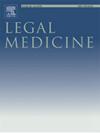Development of Piophila megastigmata (Diptera: Piophilida) at seven constant temperatures
IF 1.3
4区 医学
Q3 MEDICINE, LEGAL
引用次数: 0
Abstract
In forensic entomology, the time-related growth and development of carrion insects allows for the estimation of the minimum postmortem interval (PMImin). Piophila megastigmata (Diptera: Piophilidae) is of great significance in estimating PMImin in the late stage of corpse decay. In this paper, the development of P. megastigmata was investigated under the seven constant temperatures of 16–34 °C. The total development time at each temperature was 970.38, 824.50, 593.13, 498.25, 392.00, 385.63 and 405.87 h, respectively. The isomorphen diagram shows the trend of development during different developmental stages at different temperatures. By using a revised linear regression model, the estimated lower lethal developmental thresholds (TL) and thermal summation constant (K) were found to be 10.57 °C and 6936.78 degree hours, respectively. According to a nonlinear model, the TL, upper lethal developmental thresholds (TH), and intrinsic optimum temperature (TΦ) were determined to be 7.53, 34.68, and20.43 °C, respectively. Also, logistic function and an isomegalen diagram were constructed according to the continuous changes in larval body length, and illustrates the time required to develop to a certain length at different temperatures. The obtained results offer crucial fundamental developmental information regarding P. megastigmata, which can be applied in PMImin estimation.
在七种恒定温度下巨喙雉(双翅目:喙雉科)的发育过程
在法医昆虫学中,根据腐尸昆虫与时间相关的生长发育情况,可以估算出尸体腐烂后的最小间隔时间(PMImin)。巨翅狰狞虫(双翅目:狰狞虫科)对估算尸体腐烂后期的最小死后间隔期具有重要意义。本文研究了巨翅狰狞在 16-34 °C七个恒定温度下的发育过程。各温度下的总发育时间分别为 970.38、824.50、593.13、498.25、392.00、385.63 和 405.87 h。等值线图显示了不同温度下不同发育阶段的发育趋势。通过使用修正的线性回归模型,发现估计的致死发育下限(TL)和热和常数(K)分别为 10.57 °C 和 6936.78 度小时。根据非线性模型,TL、致死发育上限(TH)和固有最适温度(TΦ)分别为 7.53、34.68 和 20.43 °C。此外,还根据幼虫体长的连续变化构建了对数函数和等值线图,并说明了在不同温度下发育到一定长度所需的时间。所获结果提供了有关巨口蟾蜍的重要基本发育信息,可用于估计 PMImin。
本文章由计算机程序翻译,如有差异,请以英文原文为准。
求助全文
约1分钟内获得全文
求助全文
来源期刊

Legal Medicine
Nursing-Issues, Ethics and Legal Aspects
CiteScore
2.80
自引率
6.70%
发文量
119
审稿时长
7.9 weeks
期刊介绍:
Legal Medicine provides an international forum for the publication of original articles, reviews and correspondence on subjects that cover practical and theoretical areas of interest relating to the wide range of legal medicine.
Subjects covered include forensic pathology, toxicology, odontology, anthropology, criminalistics, immunochemistry, hemogenetics and forensic aspects of biological science with emphasis on DNA analysis and molecular biology. Submissions dealing with medicolegal problems such as malpractice, insurance, child abuse or ethics in medical practice are also acceptable.
 求助内容:
求助内容: 应助结果提醒方式:
应助结果提醒方式:


